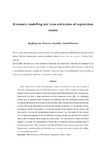Mostrar o rexistro simple do ítem
Kinematic Modelling and State Estimation of Exploration Rovers
| dc.contributor.author | Lou, Qingfeng | |
| dc.contributor.author | González Varela, Francisco Javier | |
| dc.contributor.author | Kövecses, József | |
| dc.date.accessioned | 2021-06-28T16:46:57Z | |
| dc.date.available | 2021-06-28T16:46:57Z | |
| dc.date.issued | 2019-04 | |
| dc.identifier.citation | Q. Lou, F. González and J. Kövecses, "Kinematic Modeling and State Estimation of Exploration Rovers," in IEEE Robotics and Automation Letters, vol. 4, no. 2, pp. 1311-1318, April 2019, doi: 10.1109/LRA.2019.2895393. | es_ES |
| dc.identifier.uri | http://hdl.handle.net/2183/28124 | |
| dc.description | This is a post-peer-review, pre-copyedit version of an article published in IEEE Robotics and Automation Letters. The final authenticated version is available online at: http://dx.doi.org/10.1109/LRA.2019.2895393. | es_ES |
| dc.description.abstract | [Abstract] State estimation is crucial for exploration rovers. It provides the pose and velocity of the rover by processing measurements from onboard sensors. Classical wheel odometry only employs encoder measurements of the two wheels in the differential drive. As a consequence, input noise can lead to large uncertainties in the estimated results. Also, the estimation models used in classical wheel odometry are nonlinear, and the linearization process that propagates the mean and covariance of the estimated state introduces additional errors in the process. This letter puts forward a novel wheel odometry approach for six-wheeled rovers. A kinematic model is formulated to relate the velocity of the wheels and the chassis, and later used to develop the corresponding estimation model. The components of the velocity of the chassis, decomposed in the chassis-fixed coordinate frame, are selected as the system state in the estimation, which results in a linear model. The motions of all wheels are fused together to provide the measurements. Wheel slip is considered random Gaussian noise in this kinematic model. The continuous-time Kalman filter is employed to process the model. Experimental validation with six-wheeled rover prototypes was used to confirm the validity of the proposed approach. | es_ES |
| dc.description.sponsorship | MINECO; RYC-2016-20222 | es_ES |
| dc.language.iso | eng | es_ES |
| dc.relation.uri | https://doi.org/10.1109/LRA.2019.2895393 | es_ES |
| dc.rights | ©2019 IEEE. Personal use of this material is permitted. Permission from IEEE must be obtained for all other uses, in any current or future media, including reprinting/republishing this material for advertising or promotional purposes, creating new collective works, for resale or redistribution to servers or lists, or reuse of any copyrighted component of this work in other works. | es_ES |
| dc.subject | Wheeled mobile robots | es_ES |
| dc.subject | Field robots | es_ES |
| dc.subject | Kinematics | es_ES |
| dc.subject | Sensor fusion | es_ES |
| dc.subject | Robots móviles con ruedas | es_ES |
| dc.subject | Robots de campo | es_ES |
| dc.subject | Cinemática | es_ES |
| dc.subject | Fusión de sensores | es_ES |
| dc.title | Kinematic Modelling and State Estimation of Exploration Rovers | es_ES |
| dc.type | info:eu-repo/semantics/article | es_ES |
| dc.rights.access | info:eu-repo/semantics/openAccess | es_ES |
| UDC.journalTitle | IEEE Robotics and Automation Letters | es_ES |
| UDC.volume | 4 | es_ES |
| UDC.issue | 2 | es_ES |
| UDC.startPage | 1311 | es_ES |
| UDC.endPage | 1318 | es_ES |
| dc.identifier.doi | 10.1109/LRA.2019.2895393 |
Ficheiros no ítem
Este ítem aparece na(s) seguinte(s) colección(s)
-
LIM - Artigos [51]






